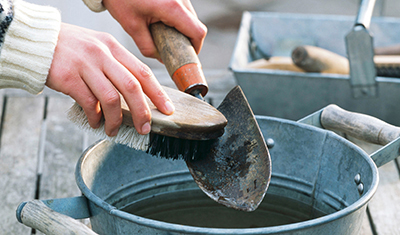Gardening tools
You don’t have to spend a fortune filling the toolshed with every gadget on the market, but you will need some basic gardening equipment to keep your garden looking its best.
“You get what you pay for” is a traditional adage, and you will indeed pay a premium for high-quality gardening tools. But well-made, sturdy tools—a spade, rake, watering can, garden hose, shears and trowel—will last a long time, so it is worth the extra expense in the long run.
LOOKING for quality
• Opt for spades and pitchforks made from stainless or chrome-plated steel. They are expensive but are the most durable and don’t rust.
• Choose small garden tools in bright neon colors—they’ll be easier to find in the grass or among weeds. The handles themselves can also be painted.
• Avoid buying gardening tools from a catalog or online. It is a good idea to try them out and see how they feel in your hands—and to check that they are not too heavy or too large.
• Where possible or appropriate, select tools that have extendable handles to make garden work much easier on the back.
GOOD TO KNOW 
Protection for working in the garden
Gloves and sensible footwear are key for working effectively and safely in the garden. For jobs that require kneeling, such as weeding or planting, knee protection is a good idea. Even a bag stuffed with rags or an old cushion will do the trick. In order to keep your fingernails clean, scratch them over a bar of soap before heading out to the garden. By filling the space between your nails and your fingers with soap, you can help keep dirt at bay.
CARE extends the service life
• Remove soil, grass cuttings or dirt immediately after using a gardening tool.
• Clean stubborn dirt from the cutting edges of clippers with warm, soapy water.
• Prevent rust on metal surfaces by wiping them with an oil-moistened rag after use.
• Wrap uncomfortable handles with a little foam material for extra cushioning.
• If there is no room in the toolshed for a wheelbarrow, stand it upright with the handles against a wall so that it won’t collect water and rust.
• Use a medium wire brush to remove encrusted grass clippings from under the lawn mower.

Avoid damage to gardening tools by cleaning them thoroughly, then drying the metal and wood parts.
PREPARATION for storage
• Sharpen the large blades of scythes or sickles with a whetstone and smaller blades with a file. Store in a toolshed or indoors, safe from the elements—but away from small fingers.
• Oil wooden handles and shafts with linseed oil to keep them smooth.
• Clean metal parts of tools with fine steel wool. Remove a light coat of rust by sanding it with medium–coarse sandpaper.
• Don’t keep metal tools on the floor. To prevent them from becoming damp and rusting, place them on a shelf or hang them from hooks screwed to the wall. Store the lawn mower on a wooden plank.
• Do not leave any wood or metal tools in the garden. Keep everything in a toolshed or indoors for protection against the weather.

